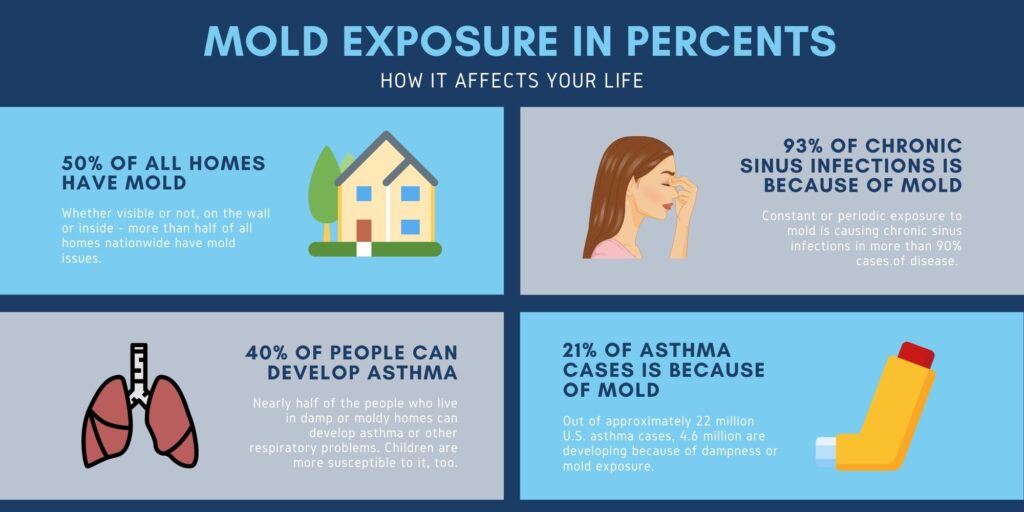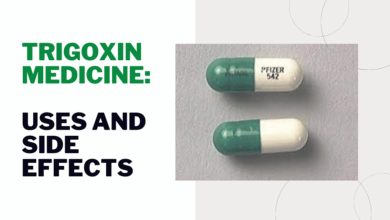Do you ever find yourself constantly sneezing or experiencing respiratory issues while indoors? The culprit could be lurking right under your nose – mold.
Mold is a common problem in homes and buildings, and its impact on our health should not be underestimated. In this article, we will delve into the world of mold toxicity to help you understand the potential risks it poses to your well-being.
Exposure to mold can lead to a range of health problems, including allergies, asthma attacks, and even more severe respiratory conditions. It is essential to identify and address any mold growth in your environment promptly. By taking preventive measures and controlling moisture levels in your home or workplace, you can significantly reduce the risk of mold growth.
Furthermore, this article will guide you through the process of identifying and removing mold from your surroundings effectively using appropriate remediation techniques.
Your health matters, so let’s explore how to breathe easy by understanding the health impact of mold toxicity.
Key Takeaways
– Mold can lead to allergies, asthma attacks, and respiratory conditions.
– Prolonged exposure to certain types of molds can result in lung infections or toxic reactions.
– Mold-related VOCs can cause respiratory issues and exacerbate asthma symptoms.
– Professional mold testing and inspection are important for accurate identification and remediation.
Common Sources of Mold in Homes and Buildings
Did you know that the most common sources of mold in homes and buildings can be found hiding in your bathroom, basement, and even under your kitchen sink? Mold thrives in warm, damp environments, making these areas prime breeding grounds. Leaky pipes or faucets, inadequate ventilation, and high humidity levels are all common causes for mold growth.
Once mold takes hold, it releases spores into the air which can cause a range of health effects when inhaled. These include respiratory problems such as coughing, wheezing, and throat irritation. For individuals with allergies or asthma, exposure to mold can worsen symptoms and lead to severe allergic reactions. Furthermore, prolonged exposure to certain types of molds may result in more serious health risks such as lung infections or toxic reactions.
Transitioning into the subsequent section about the ‘health risks associated with mold exposure,’ it is crucial to understand the potential dangers of mold toxicity on our well-being.
Health Risks Associated with Mold Exposure
Mold exposure can have detrimental effects on your respiratory system, causing a range of respiratory issues and allergies. When you come into contact with mold spores, it can trigger allergic reactions such as sneezing, coughing, and watery eyes. Additionally, individuals with asthma or other chronic conditions may experience worsened symptoms when exposed to mold.
In some cases, mold exposure can even lead to infections and toxic reactions in the body. It’s important to be aware of these health risks associated with mold exposure and take necessary precautions to prevent its growth in your home or building.
Respiratory Issues and Allergies
Take a deep breath and feel the relief as your respiratory system becomes free from the burden of allergies caused by mold toxicity.
Respiratory issues and allergies are common health risks associated with exposure to mold. When mold spores are inhaled, they can trigger an immune response in sensitive individuals, leading to symptoms such as sneezing, coughing, wheezing, and shortness of breath.
Managing these symptoms is crucial for maintaining good respiratory health. Treatment options include over-the-counter antihistamines to reduce allergic reactions and nasal corticosteroids to alleviate inflammation in the airways. In severe cases, immunotherapy may be recommended to desensitize the body’s immune response to mold allergens.
It is important to address respiratory issues promptly as untreated allergies can progress into more chronic conditions like asthma. With proper management and treatment, you can breathe easy again and prevent further complications down the line.
Asthma and Other Chronic Conditions
Get ready to experience a world of relief as you discover how managing asthma and other chronic conditions can improve your overall respiratory well-being.
Asthma, a chronic inflammatory disease of the airways, affects millions of people worldwide and can have a significant impact on daily life. However, with proper asthma management techniques, you can take control of your symptoms and reduce the frequency and severity of attacks.
Here are three key strategies for effective asthma management:
– Create an asthma action plan with your healthcare provider to track symptoms and adjust medications as needed.
– Identify and avoid triggers that worsen your condition, such as allergens or irritants.
– Practice good self-care by maintaining a healthy lifestyle and staying physically active.
By implementing these strategies, you can minimize the long-term effects of asthma and enhance your respiratory well-being.
As we delve into the next section on infections and toxic reactions, you will gain further insight into the broader health implications of mold toxicity.
Infections and Toxic Reactions
Discover the fascinating world of infections and toxic reactions, where you’ll gain valuable insight into how they can affect your respiratory well-being. When it comes to mold toxicity, invasive infections can occur in individuals who are exposed to high levels of mold for extended periods. These infections can lead to serious health complications and should not be taken lightly.
Symptoms of mold toxicity may include coughing, wheezing, shortness of breath, and chest tightness. In some cases, individuals may also experience fever, fatigue, and muscle aches. It’s important to note that these symptoms can vary depending on the individual and the type of mold present in the environment.
Understanding these symptoms is crucial in identifying mold in your environment and taking appropriate action to ensure your respiratory health is protected as we discuss in the subsequent section about ‘identifying mold in your environment.’
Identifying Mold in Your Environment
To identify mold in your environment, you can look for visual signs and discoloration on surfaces such as walls, ceilings, and floors. These may appear as dark spots or patches with a fuzzy or slimy texture. Additionally, musty odors and unpleasant smells are often indicative of mold growth.
If you suspect the presence of mold but cannot visually detect it, it’s recommended to hire professionals for mold testing and inspection to accurately assess the problem.
Visual Signs and Discoloration
Take a look around your home and notice any unusual discoloration or visual signs that could indicate the presence of mold toxicity. Conducting a visual inspection is the first step in identifying mold growth. Here are four common visual signs to watch out for:
1. Stains on walls or ceilings: Dark, patchy stains can be an indication of water damage and potential mold growth.
2. Peeling wallpaper or paint: Moisture from mold can cause wallpaper or paint to bubble, crack, or peel.
3. Visible fuzzy patches: Mold often appears as fuzzy patches with different colors like black, green, or white.
4. Warped surfaces: If you notice any warped areas on walls, floors, or furniture, it may be due to moisture from mold.
By paying attention to these visual cues, you can take proactive steps towards addressing potential mold issues in your home.
Now let’s explore another important indicator of mold toxicity – musty odors and unpleasant smells.
Musty Odors and Unpleasant Smells
Get ready to experience your senses in a whole new way – because when it comes to identifying mold toxicity, your nose knows best! Musty odors and unpleasant smells are often the first indicators of mold-related health symptoms. These odors are caused by volatile organic compounds (VOCs) released by mold spores as they grow and reproduce.
VOCs can have detrimental effects on human health, causing respiratory issues, allergies, and even exacerbating asthma symptoms. Indoor air pollutants like mold can also trigger headaches, fatigue, and difficulty concentrating.
To ensure your home is free from these harmful substances, it’s crucial to invest in professional mold testing and inspection. This comprehensive assessment will identify the type of mold present in your environment, determine its concentration levels, and provide recommendations for remediation if necessary.
With this knowledge at hand, you can take the appropriate steps to create a safe and healthy living space for you and your loved ones without delay.
Professional Mold Testing and Inspection
Don’t ignore the importance of professional mold testing and inspection when it comes to ensuring a safe and healthy living space. Professional mold testing is crucial in accurately identifying the presence of mold and determining the type and severity of the contamination.
Mold inspection involves a thorough examination of your property, including hidden areas where mold may be lurking. Here are five reasons why professional mold testing and inspection are essential:
– Identifies hidden mold sources that may not be visible to the naked eye.
– Determines the specific type of mold present, which helps in developing an effective remediation plan.
– Assesses the extent of mold contamination, allowing for targeted removal strategies.
– Provides valuable information on indoor air quality, helping to prevent health issues caused by exposure to airborne mold spores.
– Offers peace of mind by ensuring a comprehensive evaluation that leaves no stone unturned.
Understanding these crucial aspects of professional mold testing and inspection sets the stage for effectively preventing and controlling future mold growth in your home.
Preventing and Controlling Mold Growth
To effectively prevent and control mold growth, make sure you keep your home well-ventilated and promptly address any water leaks or moisture issues. Moisture is a key factor in mold development, so it’s crucial to prevent excessive humidity levels by using dehumidifiers if needed.
Proper ventilation, such as using exhaust fans in bathrooms and kitchens, helps remove excess moisture from the air. Regularly inspecting your home for leaks and promptly repairing them will also minimize the risk of mold growth.
Additionally, effective cleaning practices are essential in preventing mold. Use appropriate cleaning products specifically designed for mold removal and ensure thorough drying after cleaning any affected areas.
By taking these preventive measures, you can significantly reduce the chances of mold growth in your home.
Moving forward to discuss remediation and removal of mold…
Remediation and Removal of Mold
When it comes to remediation and removal of mold, there are a few key points that you should keep in mind.
First, if you decide to tackle the issue yourself, be sure to take proper precautions and follow DIY methods recommended by experts.
However, for more extensive mold problems or if you have health concerns, it’s advisable to hire professional mold remediation services who have the expertise and equipment necessary for effective removal.
Lastly, preventing regrowth of mold is crucial and can be achieved by addressing underlying moisture issues and implementing preventive measures such as proper ventilation and regular cleaning.
DIY Methods and Precautions
Taking appropriate precautions can help you tackle mold infestations in your home without breaking the bank. When it comes to DIY cleaning, there are natural remedies that can effectively eliminate mold. Here are some sub-lists to guide you through the process:
– Prevention:
– Control moisture levels in your home by using dehumidifiers or increasing ventilation.
– Fix any water leaks promptly to prevent mold growth.
– Ensure proper insulation and sealing of windows and doors to minimize condensation.
– Cleaning:
– Use a mixture of vinegar and water or hydrogen peroxide to clean small areas affected by mold.
– Scrub the surface thoroughly using a stiff brush.
– Dispose of contaminated materials properly to prevent further spread of mold spores.
Remember, while DIY methods can be effective for small-scale infestations, hiring professional mold remediation services is crucial for extensive or persistent mold problems. This ensures thorough removal and prevents potential health risks.
Hiring Professional Mold Remediation Services
Consider hiring professional mold remediation services to ensure a thorough and safe removal of mold in your home without the hassle and potential health risks. While DIY alternatives may seem cost-effective, they often don’t address the root causes of mold growth or fully eliminate the problem.
Professional services have the expertise and equipment necessary to identify the source of moisture that’s promoting mold growth and effectively remove all traces of mold from your home. Additionally, they can provide recommendations for preventing future mold regrowth, saving you from repeated outbreaks.
By investing in professional help, you can have peace of mind knowing that your home is free from harmful molds. Transitioning into the next section about preventing mold regrowth, it’s essential to take proactive steps in maintaining a healthy living environment.
Preventing Mold Regrowth
To ensure a mold-free environment, it’s crucial to implement preventive measures that discourage the recurrence of mold growth in your home. Preventing mold regrowth requires effective cleaning techniques and a thorough understanding of how mold thrives.
Start by identifying and fixing any moisture issues in your home, such as leaks or condensation buildup. Properly ventilate high-moisture areas like bathrooms and kitchens to reduce humidity levels.
Regularly clean and dry surfaces prone to dampness, such as shower curtains, window sills, and air conditioning units. Use a HEPA vacuum cleaner to remove any visible mold spores from carpets or upholstery.
Additionally, consider using mold-resistant products for construction or renovation projects. By implementing these preventive measures, you can significantly reduce the chances of mold regrowth in your home while protecting your health and well-being from potential hazards associated with mold exposure.
Protecting Your Health and Well-being
To protect your health and well-being, there are several key points to consider.
First, focus on improving indoor air quality by implementing proper ventilation systems and using air purifiers.
Second, regularly schedule health check-ups and monitoring to detect any potential mold-related symptoms or complications early on.
Lastly, create a mold-free living environment by promptly addressing any signs of water damage or moisture issues in your home and ensuring proper maintenance and cleaning practices are followed.
Improving Indoor Air Quality
If you want to breathe easy and stay healthy, make sure you’re improving the indoor air quality of your living space. Here are five key methods for achieving this:
– **Enhance ventilation:** Increase fresh air circulation by opening windows or using exhaust fans. Proper ventilation helps remove airborne contaminants, including mold spores.
– **Control humidity:** Maintain relative humidity levels between 30% and 50% to prevent mold growth. Use dehumidifiers or air conditioners in humid environments.
– **Eliminate moisture sources:** Address any leaks or water damage promptly to prevent mold colonization. Fix plumbing issues, repair roof leaks, and ensure proper drainage around your property.
– **Use natural mold inhibitors:** Consider using natural substances like vinegar, hydrogen peroxide, tea tree oil, or grapefruit seed extract to inhibit mold growth.
– **Regularly clean and vacuum:** Clean surfaces regularly with antimicrobial cleaners and use HEPA filters in vacuums to capture mold spores.
By implementing these strategies, you can significantly improve indoor air quality and minimize the risk of mold toxicity.
Transitioning into the subsequent section about regular health check-ups and monitoring is vital for maintaining a healthy living environment.
Regular Health Check-ups and Monitoring
Regular health check-ups and monitoring are crucial for maintaining a healthy living environment and ensuring your well-being. Regular check-ups allow healthcare professionals to assess your overall health and identify any potential health issues that may arise due to mold toxicity.
Monitoring techniques, such as blood tests, can help determine if you have been exposed to mold and if it’s affecting your health. These tests can detect the presence of mold toxins in your body and provide valuable information about the extent of exposure.
Additionally, regular check-ups enable early detection of symptoms related to mold toxicity, such as respiratory problems or allergic reactions. By staying proactive with regular monitoring, you can take necessary measures to address any potential health concerns caused by mold exposure promptly.
Transitioning into the subsequent section about creating a mold-free living environment involves implementing preventive measures and effective remediation techniques.
Creating a Mold-free Living Environment
Take control of your living environment by creating a home free from the harmful effects of mold. Preventing moisture is crucial in mold prevention strategies.
Start by identifying areas in your home that are prone to moisture buildup, such as bathrooms, kitchens, and basements. Ensure proper ventilation in these areas by using exhaust fans or opening windows to allow air circulation. Fix any plumbing leaks immediately to prevent water accumulation.
Keep humidity levels below 50% using dehumidifiers or air conditioners. Regularly clean and dry surfaces prone to dampness, like shower curtains and window sills. Use mold-resistant materials when renovating or building your home, such as mold-resistant drywall and paint. Insulate your walls properly to prevent condensation on cold surfaces.
By implementing these preventive measures, you can create a mold-free living environment that promotes good health for you and your family.
Conclusion
In conclusion, it’s crucial to understand the health impact of mold toxicity in order to protect your well-being. By being aware of common sources of mold in homes and buildings, you can take proactive steps to prevent and control its growth.
Identifying mold in your environment is key, as exposure can lead to various health risks. If mold is present, swift remediation and removal are necessary to mitigate its harmful effects on your health.
Remember, prioritizing a mold-free environment is essential for breathing easy and maintaining good health.





